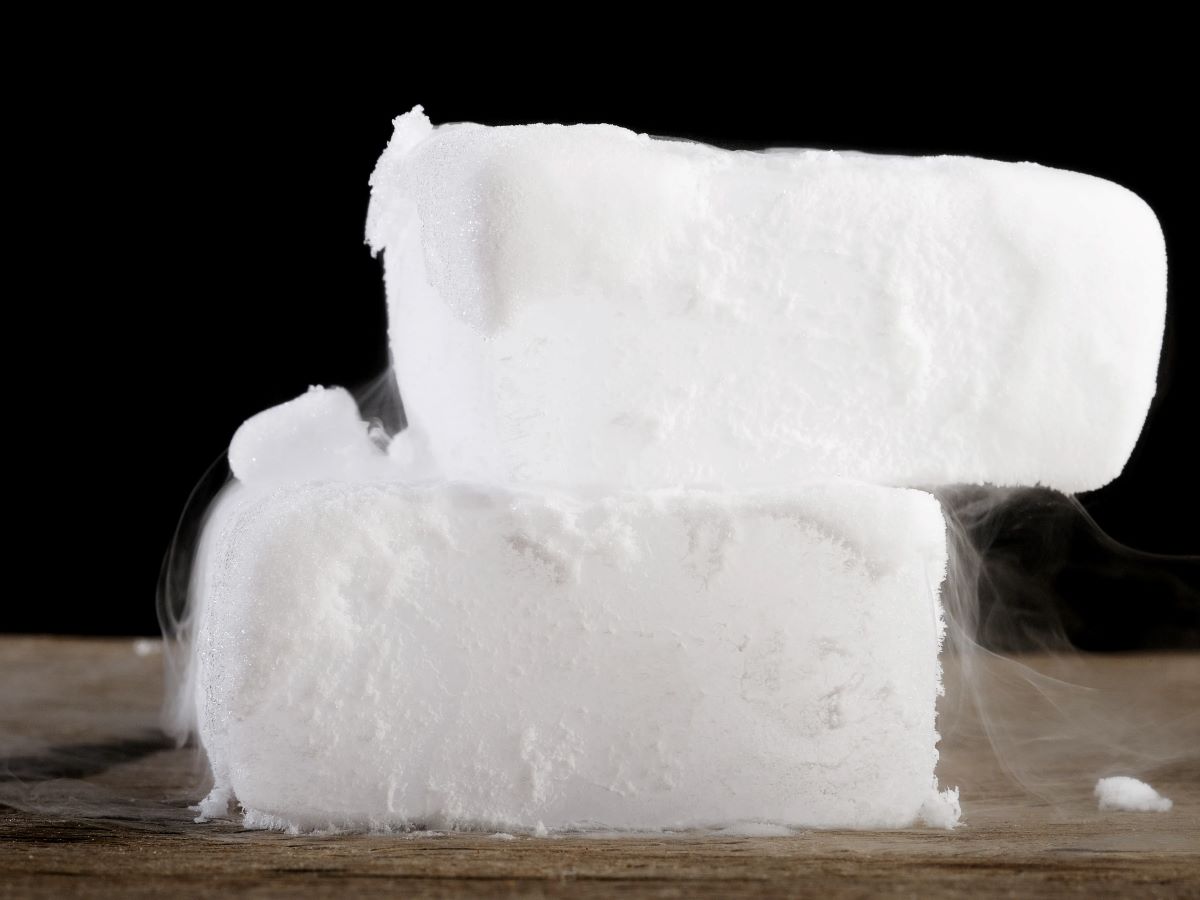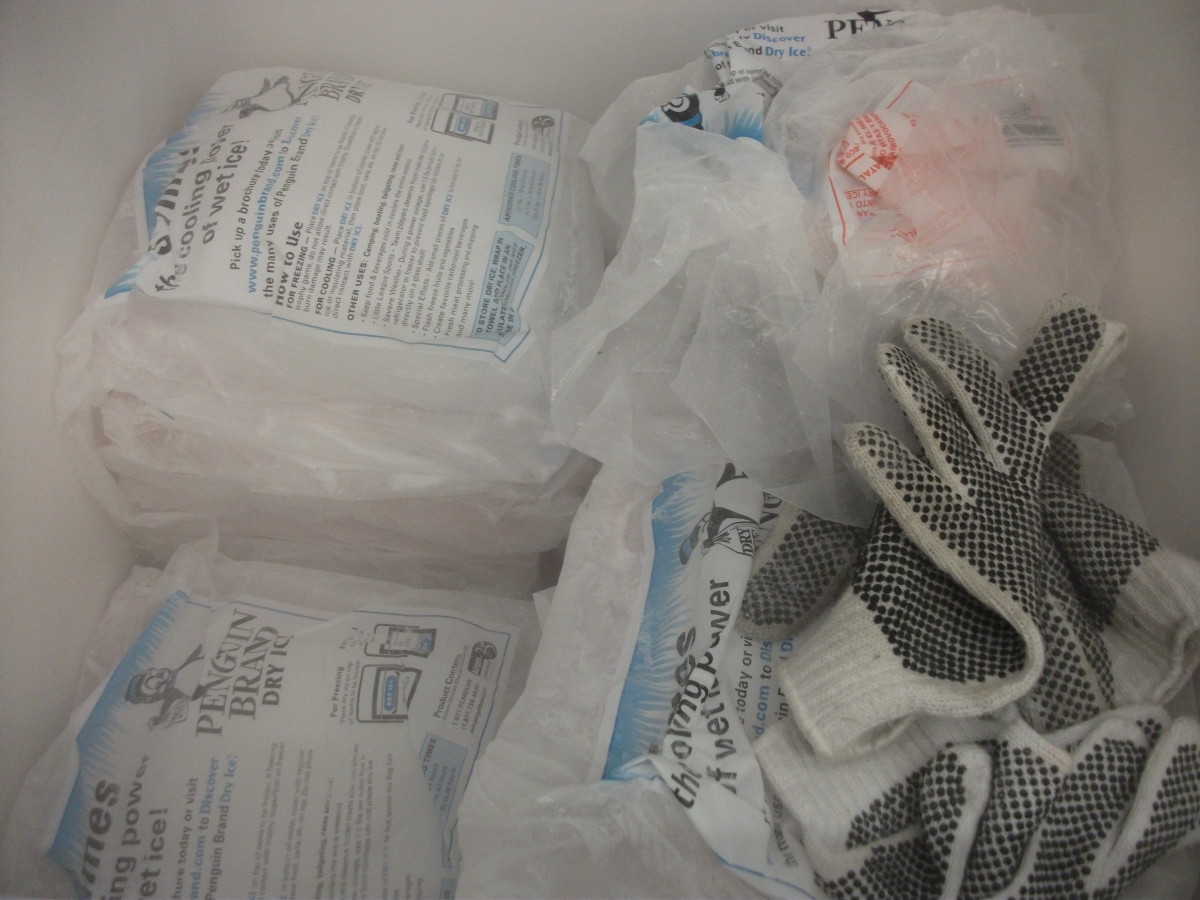

Articles
How To Store Dry Ice
Modified: February 23, 2024
Learn the best ways to store dry ice in this informative article. Find out how to safely handle and store dry ice for your specific needs.
(Many of the links in this article redirect to a specific reviewed product. Your purchase of these products through affiliate links helps to generate commission for Storables.com, at no extra cost. Learn more)
Introduction
When it comes to storing dry ice, it’s important to follow certain safety precautions to ensure your well-being and the integrity of the dry ice. Dry ice, which is the solid form of carbon dioxide, is commonly used for a variety of purposes, such as keeping items cold during shipping or creating a spooky effect for Halloween parties. However, it requires careful handling and storage due to its extreme cold temperature (-78.5°C or -109.3°F) and the potential for carbon dioxide buildup.
In this article, we will explore the various aspects of storing dry ice, including the safety precautions, choosing the right container, and monitoring temperature and ventilation. We will also provide tips for handling, transporting, and disposing of dry ice safely.
By following the guidelines outlined in this article, you’ll be able to store dry ice effectively and minimize any potential risks or hazards associated with its use.
Key Takeaways:
- Safely storing, handling, and disposing of dry ice requires prioritizing safety precautions, choosing appropriate containers, and monitoring temperature and ventilation to minimize risks and ensure effectiveness.
- Properly storing dry ice in insulated containers, monitoring temperature, and handling with caution are essential for maintaining its integrity and minimizing potential hazards. Always prioritize safety and follow local regulations for disposal.
Read more: How To Store Dry Ice In Cooler
Safety Precautions
Handling dry ice requires caution to prevent any injuries or accidents. Here are some important safety precautions to keep in mind:
- Use protective gear: When handling dry ice, it’s essential to wear thick gloves to protect your hands from frostbite. Additionally, safety goggles should be worn to shield your eyes from potential splashes or vapors.
- Ensure proper ventilation: Dry ice releases carbon dioxide gas as it sublimates, which can displace oxygen in confined spaces. When storing dry ice, make sure there is adequate ventilation to prevent any buildup of carbon dioxide. Avoid storing it in airtight containers or sealed rooms.
- Handle with care: Dry ice is extremely cold and can cause frostbite upon direct contact. Always handle it with insulated gloves or use tongs to avoid direct skin exposure. Never place it on bare surfaces or touch it with bare hands.
- Keep out of reach of children: It’s important to store dry ice in a secure location where children cannot access it. Explain the dangers of dry ice to children and discourage them from playing with it.
- Avoid swallowing or inhaling dry ice: Never consume or ingest dry ice, as it can cause serious burns or injury to internal organs. Similarly, avoid inhaling the vapors produced by dry ice, as they can cause respiratory irritation.
- Transport with caution: When transporting dry ice, ensure it is kept in a well-ventilated container and secure it to prevent any movement. Avoid using airtight containers or sealing it in the trunk of a car, as carbon dioxide buildup can occur.
- Store in a well-ventilated area: It’s crucial to store dry ice in a well-ventilated space to allow proper gas release. Avoid storing it in areas with poor ventilation, such as basements or small closets.
By following these safety precautions, you can minimize the risk of accidents or injuries while storing dry ice.
Choosing the Right Container
When storing dry ice, it’s important to choose an appropriate container that can withstand the extreme cold temperatures and prevent excessive sublimation. Here are some factors to consider when selecting the right container:
- Insulation: Look for containers that provide good insulation to minimize the sublimation rate of the dry ice. Insulated containers, such as coolers or Styrofoam boxes, are ideal as they can help maintain the cold temperature for a longer period.
- Airtightness: While ventilation is necessary to allow carbon dioxide gas to escape, it’s important to choose a container that is airtight enough to prevent excessive air exchange, which can cause rapid sublimation. Look for containers with tight-fitting lids or gaskets to minimize air leakage.
- Durability: Ensure that the container you choose is durable and can withstand the extreme cold temperature of the dry ice. Avoid using thin plastic containers that may crack or break when exposed to the low temperatures.
- Size: Consider the amount of dry ice you need to store and choose a container size accordingly. It’s recommended to leave some empty space in the container to accommodate the expanding gas as the dry ice sublimates.
- Portability: If you plan to transport the dry ice, choose a container that is portable and easy to handle. Look for containers with handles or straps for convenient carrying.
- Sealability: Ensure that the container can be tightly sealed to prevent air leakage and maintain the cold temperature. Look for containers with secure latches or locking mechanisms.
Consider these factors when choosing the right container for storing dry ice. Insulated containers with good airtightness and durability are generally the best options for maintaining the cold temperature and minimizing sublimation.
Storing Dry Ice in a Cooler
A cooler is a popular choice for storing and transporting dry ice due to its insulated design and portability. Here’s how you can effectively store dry ice in a cooler:
- Preparation: Start by ensuring that your cooler is clean and dry. Remove any food or perishable items from the cooler to make space for the dry ice.
- Insulate the cooler: Line the bottom and sides of the cooler with a layer of insulating material, such as towels or newspaper, to provide additional insulation and minimize air exchange.
- Secure the dry ice: Using insulated gloves or tongs, carefully place the dry ice in the cooler. Ensure that the dry ice is kept away from the sides of the cooler to allow proper airflow.
- Add padding: To prevent direct contact between the dry ice and any perishable items or fragile items you may be storing, place a layer of padding, such as cardboard or bubble wrap, on top of the dry ice.
- Close the cooler: Once the dry ice and items are securely placed inside the cooler, close the lid tightly to create an airtight seal. Make sure the cooler is latched or fastened to prevent any air leakage.
- Monitor the temperature: Regularly check the temperature inside the cooler to ensure it stays cold. Use a digital thermometer to monitor the temperature and make adjustments if necessary. Avoid opening the cooler frequently to maintain the cold temperature.
- Ventilation: While it’s important to keep the cooler closed, ensure that there is some ventilation to allow carbon dioxide gas to escape. Partially open the cooler lid or place it in a well-ventilated area to prevent excessive gas buildup.
- Transportation: If you need to transport the cooler, secure it properly to prevent any movement that can cause the dry ice to shift. Avoid sealing the cooler completely to allow for proper ventilation during transportation.
By following these steps, you can effectively store dry ice in a cooler, ensuring that it remains cold and minimizing the sublimation rate. Remember to always prioritize safety by wearing protective gear and handling dry ice with care.
Storing Dry Ice in a Freezer
While a freezer is not the most common method for storing dry ice, it can be used if certain precautions are taken. Here are the steps to safely store dry ice in a freezer:
- Prepare the freezer: Ensure that the freezer is clean and free of any perishable items. Remove any ice or frost buildup to make space for the dry ice.
- Protect the freezer: To prevent any potential damage to the freezer, place a layer of insulation, such as towels or cardboard, on the shelves or drawers where the dry ice will be stored.
- Transfer the dry ice: Using insulated gloves or tongs, carefully transfer the dry ice into the freezer. Make sure to handle it with caution and avoid placing it directly on the freezer shelves or against the walls.
- Positioning: Place the dry ice in a central location in the freezer, ensuring that it is not in direct contact with any food items or the freezer walls. This will allow for better airflow and distribution of the cold temperature.
- Close the freezer: Once the dry ice is securely placed, close the freezer door tightly to create a proper seal. This will help maintain the cold temperature inside the freezer and prevent any air leakage.
- Monitor the temperature: Keep an eye on the temperature inside the freezer to ensure it remains cold. Use a thermometer to regularly check the temperature and adjust if necessary. Avoid frequent opening of the freezer door to maintain the cold temperature.
- Ventilation: While the freezer should be closed, it’s important to provide some ventilation to allow for the release of carbon dioxide gas. Avoid sealing the freezer completely, as this can lead to excessive gas buildup.
- Disposal: Once the dry ice has completely sublimated, open the freezer door and allow any remaining gas to disperse. Dispose of any leftover dry ice by placing it outside in a well-ventilated area and allowing it to dissipate naturally.
It’s worth noting that using a freezer for storing dry ice may cause the freezer to lose some of its cooling capacity temporarily. Therefore, it is recommended to only use this method if there is a surplus of freezer space and proper precautions are taken.
Remember to always handle dry ice with caution and wear protective gear to prevent any injuries during the storage process.
When storing dry ice, always use insulated gloves to handle it and store it in a well-ventilated cooler or container to prevent the build-up of carbon dioxide gas. Keep the cooler in a well-ventilated area, as the gas can displace oxygen.
Read more: How To Store Dry Ice Overnight
Storing Dry Ice in Styrofoam Containers
Styrofoam containers are particularly effective for storing dry ice due to their insulating properties and ability to maintain a cold temperature for an extended period. Here are the steps to store dry ice in Styrofoam containers:
- Choose a suitable Styrofoam container: Select a Styrofoam container that is appropriately sized for the amount of dry ice you need to store. Make sure the container is clean and free of any contaminants that could affect the dry ice.
- Prepare the container: Before placing the dry ice in the Styrofoam container, insulate the inside by lining it with a layer of insulating material such as towels or newspaper. This extra layer of insulation helps to reduce heat transfer and maintain the cold temperature for a longer period.
- Transfer the dry ice: Carefully handle the dry ice using insulated gloves or tongs to prevent frostbite. Place the dry ice inside the Styrofoam container, ensuring that it is evenly distributed and not in direct contact with the container walls.
- Seal the container: Close the Styrofoam container tightly to create an airtight seal. This helps to minimize air exchange and maintain the cold temperature inside. Use tape or elastic bands to secure the lid and ensure it does not come loose.
- Monitor the temperature: Regularly check the temperature inside the Styrofoam container using a digital thermometer. If necessary, add additional insulation around the container to further reduce heat transfer and extend the storage time of the dry ice.
- Ventilation: While it’s important to keep the Styrofoam container closed, provide some ventilation to allow for the release of carbon dioxide gas. This can be done by partially opening the lid or placing the container in a well-ventilated area.
- Transportation: If you need to transport the Styrofoam container with the dry ice, make sure it is securely fastened to prevent any movement. Avoid sealing the container completely during transportation to allow for proper ventilation.
- Disposal: After the dry ice has fully sublimated, open the Styrofoam container in a well-ventilated area to allow any remaining gas to disperse. Properly dispose of the container and any remaining dry ice remnants according to local regulations.
Storing dry ice in Styrofoam containers is an effective method to keep it cold and extend its lifespan. By following these steps, you can safely store dry ice for various applications, such as keeping food or perishable items chilled or creating special effects for events or parties.
Always remember to handle dry ice with caution and wear protective gear to ensure your safety during the storage process.
Monitoring Temperature and Ventilation
When storing dry ice, it is crucial to monitor the temperature and ensure proper ventilation to maintain its integrity and safety. Here are some key considerations for monitoring temperature and ventilation:
Temperature Monitoring:
Regularly monitoring the temperature is essential to ensure that the dry ice remains sufficiently cold. Here are a few tips for temperature monitoring:
- Use a thermometer: Invest in a reliable digital thermometer that can accurately measure low temperatures. Place the thermometer in the storage container or cooler near the dry ice to obtain an accurate reading.
- Check the temperature frequently: Regularly check the temperature to ensure it remains stable and within the desired range. Fluctuations in temperature can affect the sublimation rate of the dry ice.
- Adjust insulation as needed: If you notice an increase in temperature, consider adding more insulation to the storage container or cooler to prevent heat transfer and maintain the cold temperature.
- Minimize lid opening: Avoid unnecessary opening of the storage container or cooler to minimize temperature fluctuations. Each time the lid is opened, warm air enters, potentially leading to increased sublimation of the dry ice.
Ventilation:
Proper ventilation is crucial to allow the release of carbon dioxide gas that is naturally generated as dry ice sublimates. Here are some tips for ensuring proper ventilation:
- Avoid airtight containers: While it’s important to maintain a controlled environment, airtight containers can cause the buildup of carbon dioxide gas. Choose containers or coolers with minimal air leakage to strike a balance between ventilation and temperature stability.
- Partially open containers: If using a container with a lid, consider leaving it slightly ajar to allow for adequate ventilation. This prevents excessive gas buildup while still maintaining a cold environment.
- Well-ventilated storage areas: If storing dry ice in a room or larger space, ensure that the area is well-ventilated. This allows the carbon dioxide gas to disperse and prevents dangerous levels of carbon dioxide buildup.
- Monitor gas levels: If you are storing dry ice in a confined space, consider using a carbon dioxide gas monitor to keep track of the gas levels and ensure they remain within safe limits.
By monitoring the temperature and ensuring proper ventilation, you can effectively store dry ice while maintaining its quality and mitigating any potential safety hazards. Remember to exercise caution and take necessary safety precautions when handling and storing dry ice.
Handling and Transporting Dry Ice
Proper handling and transportation of dry ice are crucial to ensure your safety and the integrity of the dry ice. Whether you’re using it for shipping, special effects, or other purposes, here are some important guidelines to follow:
Handling Dry Ice:
- Protective gear: Always wear insulated gloves or use tongs when handling dry ice to protect your hands from frostbite. Safety goggles should also be worn to shield your eyes from any potential splashes.
- Handling with care: Avoid direct skin contact with dry ice as it can cause frostbite. Never touch dry ice with bare hands or place it directly on bare surfaces. Use insulated gloves or tongs to handle dry ice.
- Use appropriate containers: When handling dry ice, use containers made of materials that can withstand the extreme cold temperatures. Insulated containers, such as coolers or Styrofoam boxes, are recommended for storing and transporting dry ice.
- Do not swallow or inhale: Dry ice should never be consumed or ingested as it can cause serious burns or injury to internal organs. Similarly, avoid inhaling the vapors produced by dry ice, as they can cause respiratory irritation.
- Avoid confined spaces: Do not store or handle dry ice in confined spaces without proper ventilation. Carbon dioxide gas is released as dry ice sublimates and can displace oxygen in enclosed areas.
Transporting Dry Ice:
- Use well-ventilated containers: When transporting dry ice, use containers that allow for sufficient ventilation to prevent excessive gas buildup. Partially open coolers or containers with vents can help regulate the release of carbon dioxide gas.
- Secure the container: Ensure that the container holding the dry ice is securely sealed or fastened to prevent any movement during transportation. This helps to minimize the risk of accidents or spills.
- Avoid airtight closures: Do not completely seal containers holding dry ice, as this can lead to pressure accumulation or potential bursting. Allow for some air exchange to safely release the carbon dioxide gas.
- Properly package for shipping: If shipping dry ice, follow the specific guidelines outlined by the shipping carrier. This usually includes using appropriate packaging materials, clearly labeling the package as containing dry ice, and adhering to any specific shipping regulations or restrictions.
- Plan for short transport times: Dry ice has a limited lifespan due to its sublimation properties. Plan your transportation accordingly, opting for shorter journeys whenever possible to minimize sublimation and ensure the effectiveness of the dry ice upon arrival.
By following these guidelines, you can safely handle and transport dry ice without compromising your safety or the effectiveness of the dry ice itself. Always prioritize personal protective gear and exercise caution throughout the handling and transportation process.
Disposing of Dry Ice Safely
Proper disposal of dry ice is important to prevent any potential hazards and ensure environmental safety. Since dry ice is the solid form of carbon dioxide, it undergoes sublimation, transforming directly from a solid to gas. Here is a guide on how to dispose of dry ice safely:
- Allow for complete sublimation: Place any remaining dry ice in a well-ventilated area at room temperature and allow it to completely sublimate. Do not dispose of dry ice in airtight containers or throw it into closed trash bins as it can cause pressure buildup and potentially burst the container.
- Do not flush it down drains: Never dispose of dry ice by flushing it down drains or toilets. The extremely cold temperature of dry ice can cause freezing or damage to pipes.
- Avoid direct contact: When handling dry ice during the disposal process, always use insulated gloves or tongs to avoid direct contact and potential frostbite.
- Allow for ventilation: Make sure the disposal area is well-ventilated to allow any carbon dioxide gas released during sublimation to disperse safely. Adequate ventilation helps prevent the accumulation of the gas, which can be harmful when inhaled in high concentrations.
- Dispose of residue: Once the dry ice has fully sublimated, dispose of any residue, such as packaging materials or containers, in accordance with local waste management guidelines. Separate them into appropriate recycling or disposal bins as needed.
- Follow local regulations: Check with your local municipality or waste management facility to determine if there are any specific regulations or guidelines for the disposal of dry ice. Compliance with these regulations will help ensure safe and responsible disposal.
- Seek professional help if needed: If you have a large amount of dry ice or are unsure about the proper disposal methods, it is recommended to seek assistance from professionals or local authorities who can provide guidance and ensure safe disposal.
Remember, dry ice should never be disposed of in a careless or haphazard manner. By following these guidelines and adhering to local regulations, you can safely and responsibly dispose of dry ice.
Always prioritize safety during the disposal process, and never hesitate to seek assistance if you have any doubts or concerns.
Read more: How To Store Dry Ice At Home
Conclusion
Storing dry ice safely and effectively requires careful consideration of various factors, including safety precautions, container selection, temperature monitoring, ventilation, and proper handling and disposal. By following the guidelines outlined in this article, you can ensure your safety, maintain the cold temperature of the dry ice, and minimize any potential risks.
When storing dry ice, it is crucial to prioritize safety precautions such as wearing protective gear, using appropriate containers, and ensuring proper ventilation. This helps to prevent injuries and create a secure environment for the storage of dry ice.
Choosing the right container is essential for maintaining the cold temperature and minimizing sublimation. Insulated containers, such as coolers or Styrofoam boxes, are particularly effective in preserving the integrity of the dry ice and extending its lifespan.
Monitoring the temperature and ensuring proper ventilation are key to keeping the dry ice in optimal condition. Regularly check the temperature and make adjustments as needed, while also allowing for the release of carbon dioxide gas through minimal ventilation.
Handling and transporting dry ice require caution and the use of insulated gloves or tongs to prevent frostbite. Selecting well-ventilated containers and securing them properly during transportation is crucial to minimize the risk of accidents or gas buildup.
Lastly, proper disposal of dry ice is important to prevent any hazards. Allow dry ice to fully sublimate in a well-ventilated area before disposing of any residue, following local waste management guidelines and regulations.
By following these guidelines, you can safely store, handle, and dispose of dry ice while ensuring your own safety and the preservation of its quality. Prioritize safety, exercise caution, and always consult local regulations for specific disposal requirements.
Remember, when it comes to dealing with dry ice, safety should always be the top priority. With the proper knowledge and precautions in place, you can make the most of this powerful cooling agent while keeping yourself and others safe.
Frequently Asked Questions about How To Store Dry Ice
Was this page helpful?
At Storables.com, we guarantee accurate and reliable information. Our content, validated by Expert Board Contributors, is crafted following stringent Editorial Policies. We're committed to providing you with well-researched, expert-backed insights for all your informational needs.














0 thoughts on “How To Store Dry Ice”